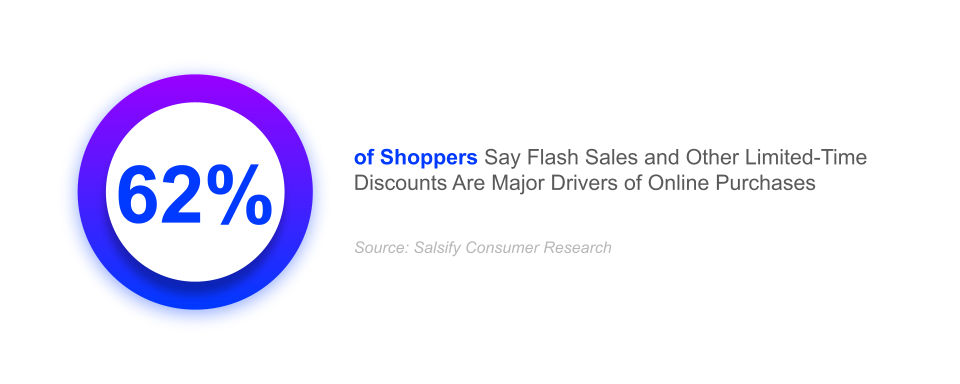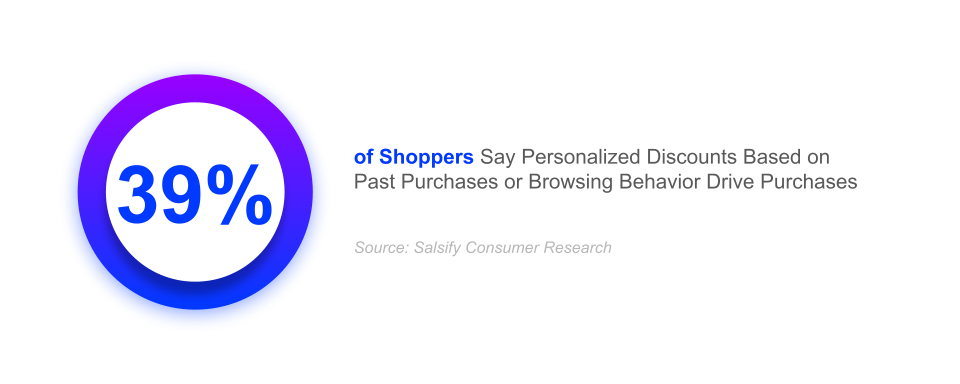The Art of the Impulse Buy: 70% of Shoppers Say Discounts Drive Unplanned Purchases — Here’s Why
Written By: Lizzie Davey
Some purchases are carefully considered. Others, not so much.
Welcome to the world of impulse buying, a.k.a. the snap decisions, late-night scrolls, and “limited-time-only” deals that shoppers can’t resist.
According to the latest “Ecommerce Pulse Report: Q2 2025” from Salsify and the Digital Shelf Institute (DSI), a whopping 70% of shoppers say they’ve made an unplanned online purchase after receiving a discount offer.

With events like Amazon Prime Day turning into a mid-year shopping holiday (with 81% of millennials planning to shop it, per Salsify research), it’s clear that impulse buying isn’t just a fluke; it’s a critical part of today’s buying journey.
But what actually drives those quick-fire decisions? And more importantly, how can brands use that insight to create smarter, more effective ecommerce experiences?
The Impulse Buy: What Is It?
Impulse buying is when someone makes a spontaneous, unplanned purchase typically driven by emotion, convenience, or the fear of missing out (FOMO). It’s not part of a carefully planned shopping list, it’s more of an “I need this right now” gut reaction. And while it may seem random, there's actually a science and strategy behind it.
In ecommerce, these quick-fire decisions are often sparked by limited-time discounts, clever messaging, or eye-catching mobile experiences that make it easy to say yes.
According to Salsify and the DSI’s latest report, brands that lean into this shopper behavior can enjoy a serious conversion boost.
The Core Factors That Drive Impulse Buying
So, what actually triggers someone to make an impulse purchase? There are a few drivers that brands can tap into, like sales and discounts.
Discounts That Feel Too Good To Miss
One of the biggest motivators for impulse buys is a juicy discount, as nearly three-quarters (70%) of shoppers have spontaneously purchased online after receiving a discount offer, per the latest ecommerce pulse report.
Whether it’s a flash sale, a promo code in their inbox, or a “limited-time-only” banner, discounts create urgency, and urgency leads to action.
Limited-Time Offers
There’s something about a countdown timer or a one-day-only deal that gets people clicking: 62% of consumers say flash sales and other limited-time discounts are major drivers of online purchases.

This is because no one wants to miss out on a good deal. It feels exclusive, time-sensitive, and exciting, which is the perfect cocktail for impulse buying.
Mobile Shopping That Makes It Easy To Buy
Smartphones are an ever-convenient device for impulse buying, and it makes sense. They’re in our hands all day, every day, which means any product we could possibly want is just a few clicks away.
Salsify and DSI research found that 59% of shoppers prefer using their phones for online purchases, which is more than desktops, tablets, or anything else. And when you pair that with one-click payment options, push notifications, and in-app deals, you’ve got a frictionless path to checkout.
Personalization and Smart Targeting
Consumers are more likely to jump on an offer if it feels tailor-made. That’s why personalized discounts based on past behavior or purchase history are such a powerful tool. In fact, 39% of shoppers say personalized offers influence their buying decisions, per Salsify and DSI research.

Emotional Triggers and “Treat Yourself” Energy
Sometimes, it’s not about the deal itself, it’s about the feeling shoppers get when they hit the “buy now” button. Whether it’s retail therapy after a long day or the thrill of grabbing a trendy item, impulse buys are often driven by emotion.
Brands that create feel-good moments through their product messaging or imagery can tap into that psychology and nudge shoppers toward that “add to cart” moment.
The Generational Differences in Impulse Buying Behaviors
Impulse buying might seem universal (and in many ways, it is), but not all generations are clicking “buy now” for the same reasons or with the same frequency.
Gen Z: The Digital Natives
This generation grew up online, so it’s no real surprise that Gen Z is especially responsive to mobile-first shopping experiences, real-time offers, and influencer-driven deals.
The “Ecommerce Pulse Report: Q2 2025” shows that 70% of scroll-happy Gen Z have made an unplanned online purchase after getting a discount offer, with 64% saying they’re likely to buy something they wouldn’t normally purchase during Amazon Prime Day.
Millennials: The Deal Seekers With Disposable Income
Millennials are pros at impulse buying: 81% plan to shop on deal-driven Prime Day, and 64% say they use the occasion to buy something special or unexpected. They love a discount, but they also value quality and convenience, so a well-optimized product page that combines persuasive storytelling, social proof, and an easy checkout can work wonders.
Gen X: The Strategic Impulse Buyer
Gen X shoppers are no strangers to shopping online, with 80% saying they’ll shop on Prime Day. However, their impulse buying tends to be more value-driven. While 72% say discounts can trigger unplanned purchases, they still want to feel like they’re making a smart choice.
Baby Boomers: The Cautious Clickers
This group is a bit more conservative when it comes to impulse purchases. Only 61% plan to shop Prime Day deals, and just 41% say they use it to buy something they normally wouldn’t. Despite this, 63% of boomers have made an unplanned purchase after being swayed by a discount, so there’s absolutely potential here.
The key with boomers is clarity and confidence. Make sure product pages are clean, easy to navigate, and packed with all the info they need.
7 Ways To Optimize Your Product Display Pages and Maximize Impulse Conversion Rates
Impulse purchases are fueled by a good product display page (PDP).
A janky layout, convoluted messaging, and missing product details can lose you a sale in seconds. Here’s how to give your PDPs the glow-up they need to convert impulse-happy browsers into buyers.
1. Lead With a Clear, Compelling Hook
Your product title and above-the-fold content should do two things:
- Grab attention; and
- Communicate value fast.
Remember, impulse buyers aren’t deep-diving right away. They need a reason to keep scrolling. Use benefits-driven language (“Lasts 3x longer than competitors” or “Softest tee you’ll ever wear”) to hook them in immediately.
2. Use Urgency Without Being Pushy
According to the report, limited-time offers drive 62% of impulse purchases. That’s huge. Countdown timers, “only X left in stock,” or tags like “Today Only” can encourage on-the-spot decisions. Just make sure the urgency feels authentic, as fake scarcity can quickly erode trust.
3. Upgrade Your Visuals
Impulse buyers are making split-second decisions, and your imagery can make or break their choice. Make sure you include multiple high-quality photos, lifestyle images that show the product in use, close-ups or texture or detail, and videos or 360-degree views.
Most importantly, check that all visuals look great on mobile since 59% of shoppers prefer using their smartphones to make impulse purchases.
Away’s PDPs feature product photos from every angle, including close-ups to show the finer details of each bag.
Image Source: Away
4. Make the Value Obvious
The biggest impulse groups, millennials and Gen Xers, want to know why your product is worth it. Use quick, scannable bullet points to call out key features and benefits. For example:
- “Machine-washable and wrinkle-free”
- “Crafted from 100% recycled materials”
- “Ships in 24 hours — free returns”
5. Feature Reviews and UGC Front and Center
Nothing fuels an impulse buy like social proof. Highlight reviews that speak to your product’s quality, speed of delivery, or surprising value. If you’ve got user-generated content (UGC) (like customer photos), surface it high on the page.
It creates an emotional connection and reassures the buyer that they’re not taking a risk — someone else has done it before, and they’re confident in the decision.
Sephora’s PDPs all feature social proof with star ratings and customer reviews.
Image Source: Sephora
6. Promote Bundles and Flash Deals Clearly
Bundles are the second most popular discount strategy behind flash sales. Let people know how much they’re saving (“$49 value for just $29”), and make it feel like they’re scoring something special.
Harry’s promotes a special bundle “just for you” and highlights how much shoppers will save if they invest in it.
Image Source: Harry’s
7. Think Thumb-First
Since most impulse buys happen on mobile, every inch of your PDP should be designed for small screens. That means fast loading times, big, tappable buttons, short, punchy copy, and vertical-friendly media.
Olipop’s product pages are simple and mobile-friendly, with a big, floating “add to cart” button and high-quality visuals.
Image Source: Olipop
Don’t Underestimate the Power of the Impulse Buy
Impulse buying is more than just a random act of retail therapy, it’s a predictable (and powerful) part of the modern customer journey.
For brands, this presents a huge opportunity.
The magic happens when great ecommerce marketing meets intentional design and psychology. Whether it’s through mobile-optimized PDPs, time-sensitive sales, or a strong dose of personalization, every small detail plays a role in nudging shoppers toward that “add to cart” moment.
Impulse buying may feel spontaneous to your customers, but behind the scenes, it’s the result of well-oiled digital marketing systems, thoughtful content marketing, and a brand that knows how to show up at the right time with the right message.
Written by: Lizzie Davey
Lizzie Davey (she/her) is a freelance writer and content strategist for ecommerce software brands. Over the past 10 years, she's worked with top industry brands to bring their vision to life and build optimized and engaging content calendars.
Recent Posts
5 Ecommerce Tips To Help Marketers Enter the New Year Stress-Free
How Many Digital Sales Channels Do Shoppers Review Before Purchasing Products?
What the Data Says About Consumer Interest in AI Shopping Agents
Subscribe to the Below the Fold Newsletter
Standing out on the digital shelf starts with access to the latest industry content. Subscribe to Below the Fold, our monthly content newsletter, and join other commerce leaders.

.svg)